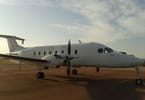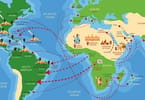As 2014 enters into its final countdown, traditionally December is a time to look back. But for people in the global Travel & Tourism (T&T) community, the only way to look ahead is up. Especially for those in aviation.
What a year 2014 has been. As the year began, a special sense of achievement was felt across the industry, from ground level to 37,000ft. A remarkable milestone had been reached. Echoing a message he has carried throughout 2014, Tony Tyler, Director General and CEO of IATA, proudly expressed once again, just last month:
“A century ago, our industry was born when Tony Jannus piloted a Benoist flying boat carrying a single fare-paying passenger between St. Petersburg and Tampa, Florida. Percival Fansler, a local businessman, conceived the idea for the airline and Thomas Benoist built the aircraft. From their collective vision, commercial aviation has evolved into the global air transport system that will safely connect some 3.3 billion travelers with nearly 100,000 flights per day across 50,000 routes this year. This activity drives economic growth, creates jobs and facilitates business opportunities. Aviation’s annual economic impact is estimated at $2.4 trillion and it supports 3.4% of global GDP.”
Aviation is an industry ever-inspiring people across the world, whether related to T&T or not, to keep looking towards the skies! The sight of an airplane is the start of wonderment: Where is it going? What flag is on the tail of the plane? Who is it carrying? Where did they take off? And what do they hope for on the other side?
With the global skies becoming busier and busier, airport runways seeing more and more takeoffs and landings, and greater and greater numbers of aircraft entering the order books, the skies look seemingly unlimited in ability to take on the dreams and demands of the travelling and trading world.
This, however, is not the case. Not if we wish growth in travel, tourism and trade to occur smoothly, safely, swiftly and cost effectively. Too much traffic would simply translate into too much risk. Which is why the aviation skies are filled with T&T Guardian Angels, also known as Air Traffic Management (ATM) professionals.
INVISIBLE TOUCH
Connecting all points of the globe through route networks, ensuring highest standards of airways management when it comes to the critical time, space, speed, and safety metrics for choreographing tens of thousands of aircraft movements across the globe every single day, ATM is there, everywhere.
Leading the charge of keeping an eye on aircraft activity in the skies is CANSO – the Civil Air Navigation Services Organization, an organization committed to improving air navigation services (ANS) both on the ground and across global skies.
As expressed by CANSO’s leader, Jeff Poole, in his role as Director General:
“Air traffic management (ATM) is the invisible part of the aviation value chain. The world’s ANSs safely handled 36.3 million flights in 2013, over 100,000 flights each day. The prime role of ATM is to ensure the safe separation of aircraft to ensure large numbers of aircraft can safely travel through airspace sufficiently far apart to minimize any risks. We see planes and airports when we travel but we only become aware of ATM when something goes wrong; perhaps there is a delay; or we might get diverted to another airport. But ATM enhances the traveler experience by ensuring planes get you to your destination as safely, efficiently and speedily as possible.”
With breathtaking growth taking place in global travel and tourism, 2012’s 1 billion international travelers reaching 2 billion by 2030, aviation has become a vital pillar in the sector’s ability to achieve sustainable economic and social impact for nations across the globe. As a result, aviation is on a growth trajectory parallel to that of global T&T, especially when it comes to traveler movements east going west.
CANSO is aware of the challenge, and opportunity, ahead when it comes to navigating such staggering demands on global air travel. As stated by Poole:
“By 2032, the industry will carry 6.5 billion passengers; and be responsible for $5.8 trillion in economic activity. ATM’s task is to cater for this growth in traffic so planes can fly, safely and efficiently. Well managed airspace ensures the smooth flow of traffic by enabling planes to fly optimal routes, thus saving time, saving fuel and reducing emissions.”
T&T and aviation are, ultimately, one. As Poole explains:
“Some 52% of international tourists travel by air. The two industries, T&T and aviation, depend on each other. We therefore place great importance on working with T&T, as well as other aviation industry partners, to ensure that ATM meets the needs of its stakeholders. This is a two-way dialogue so we also ensure that stakeholders fully understand the importance of ATM to the sustainable growth and efficiency of aviation.”
But the reality is clear. The ability to leverage opportunity is not in CANSO’s hands alone. Poole continues:
“With air traffic growing by over five percent each year there is a danger of congestion and delays, unless states invest adequately in aviation infrastructure to cater for and manage this growth. While most nation states understand that aviation supports economic activity and connectivity has a direct impact on GDP growth, we need to make it clear to them that the growth and development of aviation is dependent on efficient infrastructure. This does not just mean airports but means investment in air traffic management infrastructure as well.”
LEADING THROUGH PARTNERING
Still, seeing the world as an interconnected, interdependent environment, rather than shifting responsibility fully on nation states when it comes to finding levers for growth enablement, CANSO is taking a partnership approach.
Taking a truly win-win partnership approach, bringing respective strengths to the table in the quest for growth-supporting, green economy, solutions, Poole clearly states:
“Aviation is a highly innovative sector, but in the past few decades the technology on board aircraft has often outpaced those in air traffic control centers. There is a unique opportunity right now to modernize air navigation infrastructure. The combination of technological advances along with the commitment of nation states to implement system upgrades mean there has never been a better time to implement infrastructure improvements. Another strong argument for infrastructure improvements is the cost to airlines of inefficient infrastructure. As fuel now accounts for over one third of the operational costs for the world’s airlines, air traffic management plays an important role in helping planes fly as efficiently as possible to minimize fuel use. This also has the additional benefit of reducing CO2 emissions.”
THE THRILL OF SKY-HIGH POSSIBILITIES
With so many moving parts both within the aviation network and across the global travel landscape per se, the task of trying to traffic, not to mention control, the skies can easily be viewed as an overwhelming one. For CANSO’s Director General, however, there could be no greater position from which to experience the awe of our industry.
Speaking personally, Poole shares with noticeable energy in his voice:
“Air traffic management is a fascinating and amazing part of the aviation industry that captivates many people. It is complex and highly technical but is (and should be) invisible when it works well. It is a huge contributor to social and economic well-being by enabling connectivity across the globe. It safely handled an incredible 36.3 million flights in 2013, over 100,000 flights each day! On top of that, the industry has multiple and diverse stakeholders – States, regulators, industry partners (airlines, airports, manufacturers, etc.), staff, media, general public, etc. So in the end, despite the importance of the technology, ATM remains very much a people industry – and, uniquely, the people are friendly, professional, passionate and committed to ATM.”
As Poole considers commercial aviation’s history, and gears up for demand protected by IATA, thinking specifically of IATA Director General and CEO’s comment that:
“It took 100 years to reach 3.3 billion passengers in a year. It will take just 20 years to reach more than double that figure to 7.3 billion passengers.”
Poole’s innate ability to keep his nerves from hitting turbulence when under pressure fuels his increasing sense of service towards the industry that is his life’s work and great love.
“I am privileged and proud to be at the helm of CANSO at this time of important challenges and transformation for the ATM industry.”
2015 is ready for take-off.
WHAT TO TAKE AWAY FROM THIS ARTICLE:
- Leading the charge of keeping an eye on aircraft activity in the skies is CANSO – the Civil Air Navigation Services Organization, an organization committed to improving air navigation services (ANS) both on the ground and across global skies.
- With the global skies becoming busier and busier, airport runways seeing more and more takeoffs and landings, and greater and greater numbers of aircraft entering the order books, the skies look seemingly unlimited in ability to take on the dreams and demands of the travelling and trading world.
- With breathtaking growth taking place in global travel and tourism, 2012's 1 billion international travelers reaching 2 billion by 2030, aviation has become a vital pillar in the sector's ability to achieve sustainable economic and social impact for nations across the globe.






















